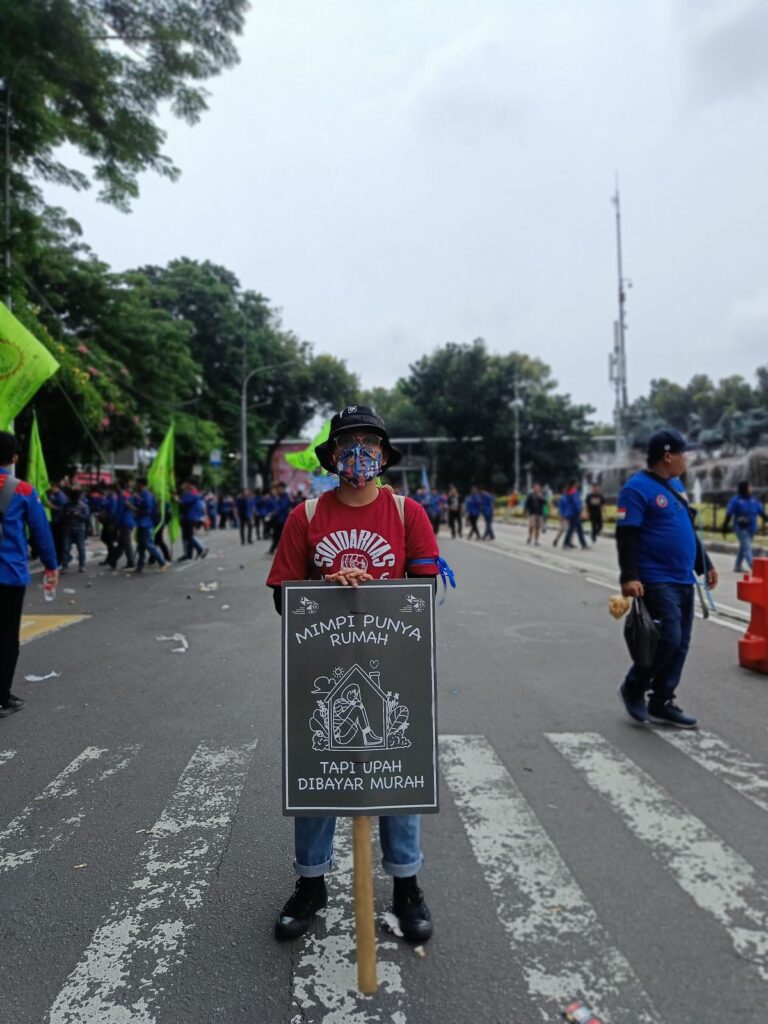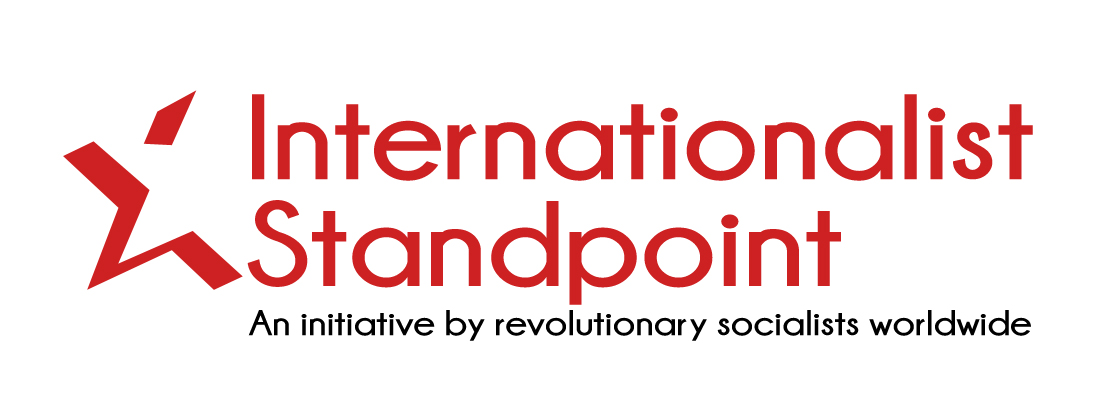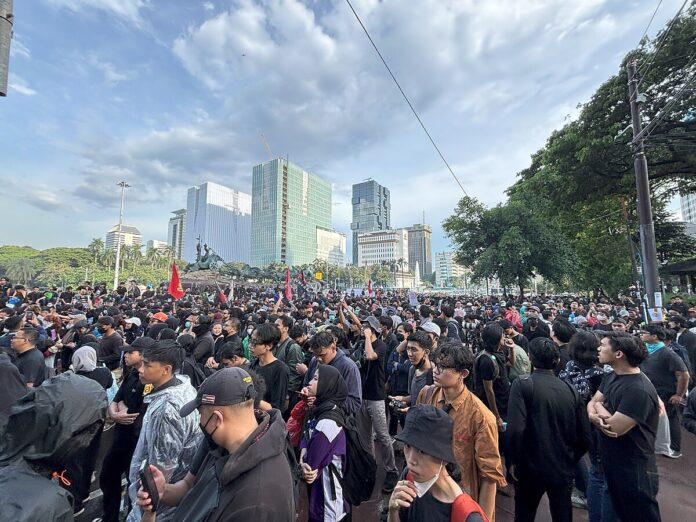Since February 2025, Indonesia was shaken by a wave of mass protests, some of the largest since the fall of Suharto in 1998. Triggered by revelations of lavish perks for lawmakers and intensified by the killing of a delivery driver, Affan Kurniawan, by police during a demonstration, the protests quickly grew into a nationwide movement. Workers, students, drivers, and communities took to the streets to denounce inequality, austerity, corruption, and repression. In this context, Internationalist Standpoint spoke with Mia Rosmiati, a young activist from the Media and Creative Industry Workers Union for Democracy (SINDIKASI), about the roots, demands, and future of this uprising. The intervew was taken by comrade Dimeji Macaulay
ISp: Can we meet you?
MR: My name is Mia Rosmiati from the Media and Creative Industry Workers Union for Democracy (SINDIKASI), where I serve in the Policy Advocacy Division at the National Executive Committee.
ISp: The internet and media are full of news about the ongoing mass protests in Indonesia. What led to this wave of protests?
MR: The protests are not a sudden outburst but the result of years of frustration. Workers, students, drivers, and families are suffocated by rising prices, stagnant wages, and job cuts, while the government responds with austerity that strips away basic services. At the same time, lawmakers enrich themselves with lavish perks such as housing allowances worth tens of millions of rupiah each month. This grotesque display of privilege, set against the daily struggles of those who can barely afford food and rent, was the spark that set the streets ablaze.
The fire spread further with the killing of Affan Kurniawan, a delivery driver crushed beneath the machinery of state violence. His death embodied the deep injustice in society and turned anger into solidarity. Affan’s name is now carried on banners, shouted in chants, and echoed online as a symbol of resistance.
What began as discontent has grown into a people’s movement: students march with workers, urban voices rise alongside rural ones, and drivers and farmers alike refuse to be silenced. For us in SINDIKASI, this is more than a protest—it is a struggle for dignity.
ISp: What was the government’s response?
MR: The government’s response has been nothing short of insulting. Instead of addressing the people’s demands, it offered cosmetic gestures—revoking a housing allowance here, suspending a foreign trip there, freezing some salary increases for lawmakers. These changes do not touch the root of the problem: a system designed to enrich a small elite while demanding endless sacrifice from the majority.
At the same time, the state has chosen repression over dialogue. Police have answered chants with tear gas, banners with batons, and dissent with arrests. The killing of Affan Kurniawan is the clearest proof that the state values its power more than the lives of its people. Rather than seeking accountability, President Prabowo brands the protests as “leaning towards treason or terrorism.” This is the language of authoritarianism, an attempt to silence the people by criminalizing their demands for justice.
Such a response exposes the hollowness of the government’s promises. Empty slogans and police violence cannot hide the truth: Indonesia belongs to its people, not to those who exploit and betray them.
ISp: What are the key demands of the movement?
MR: The demands are rooted in justice, dignity, and structural change. Protesters are not asking for small adjustments but for a complete reordering of priorities in Indonesia.
- Accountability: Independent investigations and justice for the killing of Affan Kurniawan and other victims of police brutality, and an end to state violence.
- End to elite privileges: The permanent abolition of massive housing allowances, foreign junkets, and other perks that mock the struggles of ordinary citizens.
- Economic dignity: Rejecting austerity, and demanding policies that protect workers, stabilize prices, secure jobs, and direct public resources toward the people instead of elites or military expansion.
- Democratic integrity: Defending civil liberties, resisting military influence in civilian life, strengthening oversight bodies, and protecting the right to protest without fear.
Taken together, these demands are not for reforms at the margins but for a transformation of governance—putting the needs of the many above the privileges of the few.
ISp: How did the police respond to the protests? Have you witnessed or experienced any violence or excessive force?
MR: The police response has been marked by violence, intimidation, and excessive force. Peaceful demonstrations were met with tear gas, water cannons, beatings, and mass arrests. Protesters—including students and delivery drivers—were chased through city streets, detained without clear charges, and in many cases brutally assaulted. Many have reported injuries from tear gas canisters, rubber bullets, and baton strikes.
These are not isolated claims. Hundreds of videos on social media show officers beating unarmed demonstrators, firing gas directly into crowds, and dragging students into vans. Every clip uploaded becomes both evidence and testimony, fueling public outrage. This is not “security enforcement”—it is repression. When citizens demand dignity, the state answers with violence.
ISp: What forms of organising of the movement have been established? In which ways are people mobilised?
MR: The movement has taken shape through decentralized networks of solidarity rather than rigid hierarchies. Students, workers, drivers, artists, influencers, and ordinary citizens coordinate collectively, making the protests harder to suppress.
Campuses have become vital centers of mobilization, while unions and labor groups connect workplace struggles with the broader demands of the movement. Delivery drivers and gig workers have emerged as a powerful force both on the ground and online. Influencers and public figures amplify protest messages and live footage, making it harder for the state to control the narrative.
Social media has been one of the strongest tools of self-organization. Hashtags like #IndonesiaGelap, #1312, and #ACAB spread rapidly, alongside shared templates and toolkits. Profile pictures turned into the movement’s colors—brave pink and hero green—creating visual unity and allowing people unable to march to show solidarity online.
Beyond digital spaces, local communities provide food, shelter, supplies, posters, and songs, while grassroots networks raise donations to sustain those on the front lines. What makes this movement powerful is precisely this self-organization from below: mobilization happens in classrooms, workplaces, neighborhoods, and online feeds alike, turning every space into a site of struggle and every person into an organizer.
ISp: How do you think these protests reflect broader social tensions or frustrations within Indonesian society?
MR: These protests are not an isolated flare-up but a mirror of deep fractures within Indonesian society. They express years of inequality, the arrogance of power, and the erosion of trust between the people and the state.
At the heart lies the gulf between elites and ordinary citizens. Lawmakers enjoy lavish allowances while millions struggle to afford food, rent, and education. Austerity cuts fall on schools and public services, while money flows freely into political perks and military projects. The system demands sacrifice from the many so the few can thrive.
The anger is also generational. Students face rising tuition and shrinking opportunities; workers endure layoffs, stagnant wages, and job insecurity; delivery drivers risk their lives in a gig economy that offers only precarity. For many, the movement is about reclaiming dignity and demanding a fairer future.
Police brutality has further exposed the authoritarian reflexes of the state—tear gas, arrests, and deadly force instead of dialogue. It reinforces fears that democracy is being hollowed out as oversight bodies are weakened and dissent criminalized.
These protests reflect a society no longer willing to tolerate inequality and repression. But they are more than a reflection: they are a spark of transformation. What is unfolding is not just resistance to today’s policies but the birth of a larger struggle for justice, dignity, and democracy.
ISp: What do you hope will be the outcome of these protests, and how do you think they might impact Indonesia’s future?
MR: These protests are about more than allowances or austerity; they are about justice, dignity, and systemic change. We hope they force the state to take responsibility for its violence, end elite arrogance, and put people’s needs above political perks and militarization.
Beyond that, they carry the hope of real economic and social change—budgets that prioritize schools, healthcare, jobs, and wages instead of military expansion or the comfort of a few. We want a society where young people see a future worth fighting for, and a democracy that is real, not hollow: one where dissent is respected, and institutions serve the people rather than ruling over them.
Most importantly, we hope these protests awaken people not to be fooled again by politicians during elections. Too often, votes are bought with handouts, empty promises, or cynical appeals, while society pays the price for years afterward through inequality and repression. This moment must be more than a protest; it must be a political awakening. What Indonesia needs is systemic change, not cosmetic reforms.




